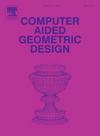三参数最小二乘渐进迭代逼近及其收敛性分析
IF 1.7
4区 计算机科学
Q3 COMPUTER SCIENCE, SOFTWARE ENGINEERING
引用次数: 0
摘要
在大规模数据拟合领域,由 Deng 和 Lin(2014 年)提出的最小二乘渐进迭代逼近(LSPIA)方法因其简单有效而成为几何迭代技术中的佼佼者。在此,我们采用三参数修正法对控制点进行微调,即 TLSPIA 方法。在 TLSPIA 框架内选择一个合适的参数,就能将其还原为传统的 LSPIA 及其变体,如 Liu 等人(2024 年)提出的 PmLSPIA。通过对配位矩阵进行奇异值分解,我们推导出了 LSPIA、PmLSPIA 和 TLSPIA 方法产生的误差序列的闭合形式,证明这些序列呈现线性下降,并在与配位矩阵的任意右奇异向量相对应的不同子空间中收敛率发散。我们还提供了经验数值示例来证实我们的理论主张,突出了所提算法的实用性和有效性。本文章由计算机程序翻译,如有差异,请以英文原文为准。
On the triple-parameter least squares progressive iterative approximation and its convergence analysis
In the domain of large-scale data fitting, the least squares progressive iterative approximation (LSPIA) method, introduced by Deng and Lin (2014), stands as a prominent figure in geometric iterative techniques due to its simplicity and effectiveness. Herein, we incorporate a triple-parameter modification to fine-tune the control points, hereby denoted as the TLSPIA method. Opting for a suitable parameter within the TLSPIA framework reverts it to the traditional LSPIA and its variant, such as PmLSPIA proposed by Liu et al. (2024). Through singular value decomposition of the collocation matrix, we derive closed forms for the error sequences generated by the LSPIA, PmLSPIA, and TLSPIA methods, demonstrating that these sequences exhibit linear decrease and diverge in their convergence rates across different subspaces corresponding to any right singular vector of the collocation matrix. Empirical numerical examples are provided to substantiate our theoretical claims, highlighting the practical viability and efficacy of the proposed algorithm.
求助全文
通过发布文献求助,成功后即可免费获取论文全文。
去求助
来源期刊

Computer Aided Geometric Design
工程技术-计算机:软件工程
CiteScore
3.50
自引率
13.30%
发文量
57
审稿时长
60 days
期刊介绍:
The journal Computer Aided Geometric Design is for researchers, scholars, and software developers dealing with mathematical and computational methods for the description of geometric objects as they arise in areas ranging from CAD/CAM to robotics and scientific visualization. The journal publishes original research papers, survey papers and with quick editorial decisions short communications of at most 3 pages. The primary objects of interest are curves, surfaces, and volumes such as splines (NURBS), meshes, subdivision surfaces as well as algorithms to generate, analyze, and manipulate them. This journal will report on new developments in CAGD and its applications, including but not restricted to the following:
-Mathematical and Geometric Foundations-
Curve, Surface, and Volume generation-
CAGD applications in Numerical Analysis, Computational Geometry, Computer Graphics, or Computer Vision-
Industrial, medical, and scientific applications.
The aim is to collect and disseminate information on computer aided design in one journal. To provide the user community with methods and algorithms for representing curves and surfaces. To illustrate computer aided geometric design by means of interesting applications. To combine curve and surface methods with computer graphics. To explain scientific phenomena by means of computer graphics. To concentrate on the interaction between theory and application. To expose unsolved problems of the practice. To develop new methods in computer aided geometry.
 求助内容:
求助内容: 应助结果提醒方式:
应助结果提醒方式:


